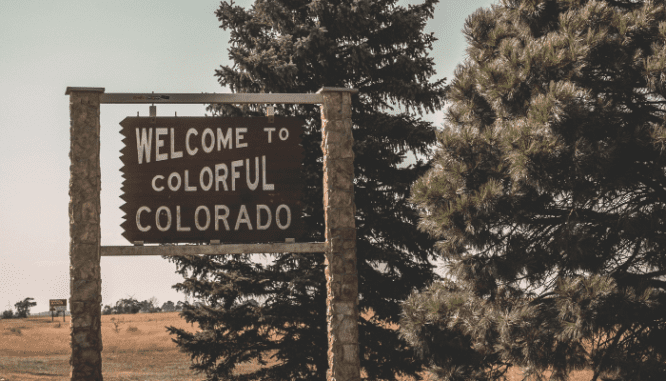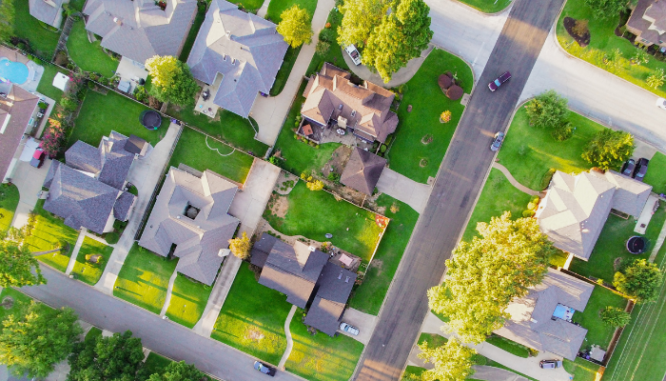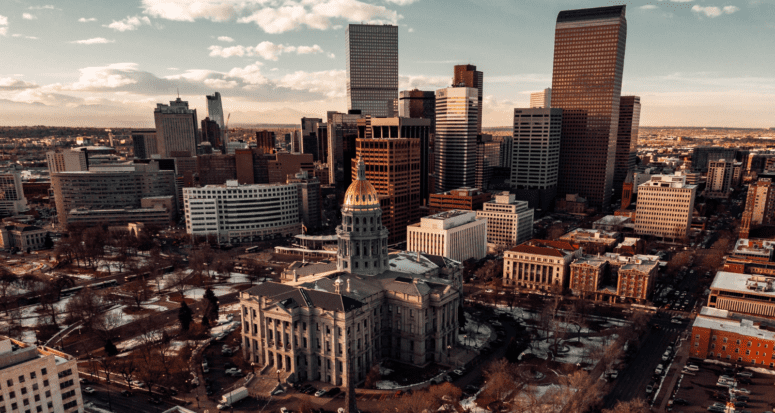Denver, Distilled: A Guide to Buying a House in a Neighborhood That’s Right for You
- Published on
- 15 min
-
 Alison Hunter, Contributing AuthorClose
Alison Hunter, Contributing AuthorClose Alison Hunter Contributing Author
Alison Hunter Contributing AuthorIn addition to real estate, Bay Area native and quasi-techy Alison Hunter also writes about the intersection of art, culture, and technology.
-
 Amber Taufen, Former Managing Editor, Buyer Resource CenterClose
Amber Taufen, Former Managing Editor, Buyer Resource CenterClose Amber Taufen Former Managing Editor, Buyer Resource Center
Amber Taufen Former Managing Editor, Buyer Resource CenterAmber was one of HomeLight’s Buyer Center editors and has been a real estate content expert since 2014. The former editor-in-chief at Inman, she was named a “Trendsetter” in the 2017 Swanepoel Power 200 list, which acknowledges “innovators, dealmakers, and movers-and-shakers who made a noteworthy impact over the last year” in real estate, and her assessment of revenue and expenses at the National Association of Realtors won a NAREE Gold Award for “Best Economic Analysis” in 2017.
Fun fact! The purple mountains noted for their majesty in the song “America the Beautiful” are none other than Colorado’s own Rocky Mountains (Pikes Peak, specifically). This mountain range traces an iconic contour between the land and the sky for 3,000 miles from New Mexico to Canada, but there is no other place that celebrates the Rockies (and The Rockies) quite like Denver.
As much as Denverites love to kick back and admire the serene beauty of the mountains, they also love to load their cars with toys and head to the mountains. Westward weekend migrations are common year-round for folks who love snow sports, biking, climbing, trekking, hiking, boating, flying, fishing, and pretty much any adventurous activity under the sun, which just happens to shine on Denver an average of 300 days per year.
In recent years, Denver has also established itself as an authentic big city, with loads of amenities including world-class museums, a thriving arts scene, nightlife, and high-end shopping.
So whether you’re into plein air painting or paragliding, Denver is among the most desirable places to buy a home in 2022. But it can be tricky getting your bearings in a city that lists dozens of neighborhoods and also boasts a supply-and-demand mismatch that does not favor the buyer. Being the hopeful, enterprising, and optimistic folks we are at HomeLight, we’ve rolled up our sleeves to help you through what might otherwise be a harrowing process: finding the best neighborhood to buy a house in Denver in 2022. We’ve even narrowed it down to a tidy list of seven.
To do this, we looked at the price, style, and age of homes available. We checked for a pulse on things like nightlife, dining, and outdoor recreation. We considered commuting, plans for development, and we even painted a picture of the type of home buyer we think would thrive in each of our chosen neighborhoods.
So read on if you want the inside scoop on where to buy in the Denver metro area.

Colorado Avalanche*!
*except it’s people, and they are moving to Denver
It’s impossible to say for sure, but the recent super-surge in the population of Denver is likely another result of the pandemic and new work-from-home policies adopted by many companies. According to agent Brian Dixon, who completes 13% more sales than the average agent in his area, there are about 100,000 people moving to Colorado every year — and about two-thirds of them are moving to Denver.
If you want something more granular, check out the stats on Denver from the National Association of Realtors®. We rely on NAR for their library of statistics and analytics. The data they produce is “the tea” industry folks spill when we gossip, and here’s the hot take on Denver from the most pristine source: inventory is low, and prices are high. Some would say, a Mile High… But with a little help from a good agent, you can find the right neighborhood to make your Denver dreams come true.
Speaking of agents, Monica Graves, in addition to being a woman who can help you buy or sell a home like falling off a log, is on a mission to educate.
Graves encourages many first-timers to get their foot in the door (heh) by buying a condo or townhome instead of the single-family unit they may have envisioned. The idea is to build equity! To get that generational wealth growing (or keep it flowing!) and don’t spend more than you can handle.
Equity is equity, and according to Graves, the prices for condos and townhouses are going up at the same rate as single-family homes. Keep this in mind as you’re house-dreaming while reading this article.
The 7 best neighborhoods in Denver to buy a home
These stand-outs represent both the up-and-coming and the time-tested neighborhoods of Denver — because, of course, not all buyers are the same. In fact, you’ll notice this is not a ranked list. It’s alphabetized because we recognize every buyer’s dream is different.
We won’t cover schools or crime data. Unlike most cities, Denver allows parents to choose the public school they think will be best for their little munchkin … and we’re too loyal to good data to drag you through the bad data that most crime statistics present as facts.
Finally, let’s rip the band-aid off: the median price for a single-family home in the Denver metro area as of March 2022 is, according to agent Dixon, about $650,000. But what does that get you?
Barnum Park
You know that feeling when something is so good that you don’t want to tell other people about it because then it’ll become popular and then it won’t be as good anymore? We feel this way about Barnum Park.
First of all, if the name Barnum maps to “circus!” in your brain, then your mental GPS is correct. The neighborhood is named for PT Barnum.
The average price in this area for a single-family home, according to Graves, hovers right around $450,000 for homes that were built in the 1930s and 1940s (think Tudors). Most are in what we’d call “decent” shape — nothing unsound or unsafe, but in need of a little zhuzhing.
Commute time to downtown is about 15 minutes by car (under normal, humane traffic conditions) and about 30 minutes by public transportation. You can also do that commute by bike in about 30 minutes if you love to experience that thin mountain air.
The neighborhood is a little anemic when it comes to restaurants and nightlife, but the folks on Yelp give lots of love to the dog park, the lake, and the recreation center located at Barnum Park, and with its close proximity to downtown residents can easily hop in the car or on a bus to scratch that big city itch.
We can’t wrap up our endorsement of Barnum without giving a quick nod to a couple of neighborhoods that are technically not part of the Denver metro area but are worth mentioning.
According to Graves, and her 29 years of experience with the area, the trick for first-time homebuyers is to focus their search to properties south of Sixth Avenue, which runs east/west between I-70 and I-25 — because as you go north, home prices go up.
Graves recommends Sheridan and Harvey Park as great neighborhoods to consider if you’re looking to buy a home near Denver in 2022. Commuting downtown from either is not ideal (Harvey Park is 30 minutes by car and twice that by bus, and Sheridan is about the same), but here’s a hot take:
If mid-century modern is your thing, Harvey Park is your place. This neighborhood is full of 1950s-built gems, which are currently selling for about $525,000. If you have money to invest in renovations and updates, these stylish gems, which are largely untouched, can be turned into high-dollar re-sales to an eager MCM market. Graves says she often sees them sell for upward of $800,000.
Remember: don’t tell anyone.
Central Park (formerly Stapleton)
Central Park is the largest neighborhood in the Denver metro area, and it’s got a little bit of something for everyone.
Home styles span the entire sweep of possibilities: condos, duplexes, row homes, live-work homes, single-family homes, and apartments are all available.
This neighborhood makes the cut because we know some of our readers will love the neighborhood vibes in Central Park, where, agent Brendan Bartic jokes, there is a community pool every 15 feet.
Bartic says this area is a young family’s paradise if your dream is manicured lawns and PTA meetings as far as the eye can see. This is a place of turn-key properties and free-range kids.
Another stand-out is access to downtown: A convenient RTD line can take you from Central Park to Denver International Airport in about 45 minutes, which is about the same amount of time it takes to get downtown.
Though it has an on-again, off-again relationship with lists that rank the highest average household income ZIP codes in the Denver Metro Area, a quick peek at the homes currently available shows the median price in keeping with what you’d expect to see in the Denver Metro: slightly above $650,000, and that is after throwing out some million-dollar outliers in our Google research/napkin math methodology.
One more thing, and we want you to hear it here first: Stapleton was the former moniker of this area — as in Benjamin Franklin Stapleton, who was a two-term mayor of the city of Denver … and a prominent member of the local Ku Klux Klan. So “Central Park” it is!
City Park
What do we love about City Park? Well, it’s mostly the park!
In addition to great views of downtown, City Park (the actual park) is home to the Denver Museum of Nature and Science (totally awesome) and the Denver Zoo (animals!), and the Denver Museum of Miniatures, Dolls and Toys (cuuuuuuute!).
But what’s it like to buy a home in the City Park Neighborhood? Well… it’s expensive. And difficult. The housing stock is minimal (about half of the neighborhood is the park), original (again, think 1880s Tudors), and highly coveted. The bottom end of the price range starts at around $800,000.
Dining and nightlife are not among the highlights of this area, but getting downtown is easy-breezy: 10 minutes by car, 15 minutes if you take the bus.
Of all the neighborhoods on this list, City Park is among the least likely to go through any kind of massive renovation or redevelopment — not that those are necessarily bad things. Change can be good. We like change … but we also like when old homes are thoughtfully maintained and off-beat coffee shops and cool stores earn loyal patrons. And we have a hunch City Park will forever be one of those “If only I’d bought a home here 20 years ago, I’d be rich!” kind of places.
Quick recap: City Park is pricey and the housing stock is low. So why did it make our list?
Well, quite simply City Park cannot be beaten if you want to paddle around a lake in a boat shaped like a duck while admiring the awkward beauty of an actual pelican. City Park also holds a free summer concert series and generally maintains its status as the park in Denver. It’s one of the oldest public spaces in Denver, and we just think that’s cool, especially after a certain pernicious virus taught us all to really appreciate well-designed outdoor spaces.

Highland (LoHi, Sunnyside, Berkeley) a.k.a. North Denver
This is a three-for-one recommendation: the area known as the Highland (North Denver) has three distinct neighborhoods called LoHi (Lower Highland), Sunnyside, and Berkeley.
LoHi is the most expensive of the three. Making way for modern condos and duplexes, the older single-family homes of LoHi were bulldozed to near extinction. Now, the area is mostly known for the landmark Glass House condo building, where you can live large and gaze down upon the immensity of the land for as little as $500,000 for an 826-square-foot one-bedroom, one-bath condo.
Another well-known and very cool feature of LoHi is Millennium Bridge which allows pedestrians to make a bird’s-eye beeline to downtown.
Sunnyside and Berkeley hold most of north Denver’s single-family homes. A boom in development in the 1920s led to a lot of new homes being built, many of which are still standing, and are “amazing,” according to Graves. She reports that Victorians and bungalow-style homes sell in this area for between $600 and $1,000 per square foot.
RiNo (River North)
Bartic says RiNo is “where it’s at” — and that is a direct quote! Them’s also fightin’ words for anyone who thinks LoDo (Lower Downtown) is the true location of where “it” is at, but we’ll get to that later. For now, we’re going to trust Bartic’s hard-won expertise on the subject and trust him when he says that RiNo is the new LoDo.
RiNo, or more formally, River North Arts District, “where art is made,” used to be the city’s warehouse district. Today, however, RiNo is a hive of hip. When old, industrial buildings were reincarnated as studio spaces, people started to flock to this area, first for the art and open studios, then as the area matured, people stayed for the bars, nightlife, cool shops, and all the “it” this neighborhood has in abundance.
Dining in RiNo can be an event in itself. Food halls, like the Denver Central Market, where multiple restaurants occupy a single indoor space, are an increasingly popular way to dine out. And, coming as a surprise to absolutely nobody, there are plenty of craft brews to be found and downed in RiNo at a number of boutique breweries. And for live music, Mission Ballroom is giving Red Rocks some competition (yeah, we said it) when it comes to booking musical talent, with its massive footprint and state-of-the-art sound system.
RiNo’s proximity to other hip spots increases its appeal: it’s close to downtown, it’s close to Coors Field, and it is easily accessible by I-70.
Bartic says single-family homes (and condos!) in the area are selling for around $600,000, which feels unreasonably reasonable given the white-hotness of this neighborhood. Available homes are all newly constructed with a decidedly modern (but not ultra-modern) aesthetic.
We expect a buyer on the younger side (what even is that? is 60 still the new 40?) will feel the most at home here. RiNo is good for folks who wake up wondering “What’s going on around here today?” and don’t mind that the whole community is a work in progress.
Uptown (North Capitol Hill)
Are you a bright-eyed, young professional who works downtown? If so, Uptown might be the perfect place for you to call home.
The Uptown neighborhood is close to City Park (swoon) and has bars and restaurants aplenty. You’re covered from fine dining to take out.
What about cool boutiques? Yep. It also has easy access to I-70 and I-25, and it is so close to downtown public transportation that driving, walking, biking, and nearly any other mode of transportation is a reasonable way to get downtown, you wonderful, bright-eyed, young professional.
But wait! There’s more!
In the wise and exquisitely diplomatic words of Bartic, this area is “entry-point sensitive” for first-time buyers thanks to the abundance of “old” condos built in the 1990s. What these properties lack in old bungalow charm or modern amenities, they make up for in affordability, and this is a shocker: The average single-family condo goes for around $335,000. Why, how, what now? Well, these 90s buildings sit right between the two types of homes most Denver buyers want: they are neither sleek and modern, nor charming and venerable.
It’s hard to say what the future holds for this neighborhood, but if your bright eyes lit up reading about Uptown, find yourself an agent and start looking!
Washington Park
Another park?! Yep. Washington Park (Wash Park, for the initiated) makes its way to lists like these all the time, and we think it’s earned every single spot on every “best of” list. This neighborhood offers a suburb-like feel near the heart of the city, and for some, that is the perfect Norman to their Rockwell.
Bartic says you can expect home prices to start in the $800,000s and those can soar into the millions. Yikes? Yeah.. yikes.
Though this iconic neighborhood is probably not right for most first-time homebuyers, it makes the list because HomeLight is always thinking one step ahead. This is a perfect neighborhood to buy if you’re coming in on the wings of some kind of equity, like the sale of the condo Graves wisely advised you to buy a few years ago, or maybe you’re related to the person who invented sliced bread. Whatever the case, if you can swing it, buy it.
As you’d expect with the high prices, most of the available housing stock is single-family homes.
The neighborhood, south, and west of the heart of the city, has an orientation that is tall and thin (think of a short baguette, unsliced) so your commute downtown can depend a lot on which end of the neighborhood you call home. There are but a few lonely bus lines that run from Wash Park to the heart of the city, so public transit from the mid-baguette to Denver will take about 45 minutes, but with any luck (and the grace of the mystical forces of traffic), a car will get you there in 15 minutes.
This is a sleepy outpost with tremendous offerings for quiet stay-at-home types, and not much for the fine diners, cocktail sippers, or rug cutters.
No-No to LoDo
Conspicuously missing from this list is the well-known neighborhood of LoDo (Lower Downtown). Bartic suggests that this place is on its way out. “It’s kind of a ghost town at night”, he reports. And he doesn’t mean the cool, Old West kind.
Are there still things to do there? Yes. Coors Field isn’t going anywhere anytime soon, so if you’re a baseball fanatic, that alone might be an unbeatable selling point. And depending on who you talk to, LoDo is indeed, as the kids say, still poppin’ off.
Some would argue that because LoDo is home to Denver’s oldest bar (hoppin’ since 1873), no newcomer can take the crown, but we think the cat is out of the bag on this neighborhood. In fact, we think the cat is now chilling, aloof and sipping tea, in RiNo — as cats do.

Find a not-so-secret agent
While we stand behind our recommendations for the best neighborhoods in Denver to buy a house, all of our research and interviews don’t hold a drippy birthday candle to the kind of support a good buyer’s agent can provide to you. This is true for folks looking to buy homes in cities across America but is especially relevant where the housing stock is low and the desire is high.
Here’s where the spy stuff comes in: you must remember that an agent will have access to more information than you do when it comes to what is on the market (and when and where). It happens all the time that the little old lady who’s ready to move out of your would-be dream home doesn’t want to list her property publicly. No MLA listing = you have no way of knowing it’s going on the market. But your not-so-secret agent does! Work with one who knows the neighborhoods in Denver backward and forward; we’ve got recommendations in case you’re not sure who that is. Good luck finding a permanent spot to park your Subaru!
Header Image Source: (Colin Lloyd / Unsplash)
